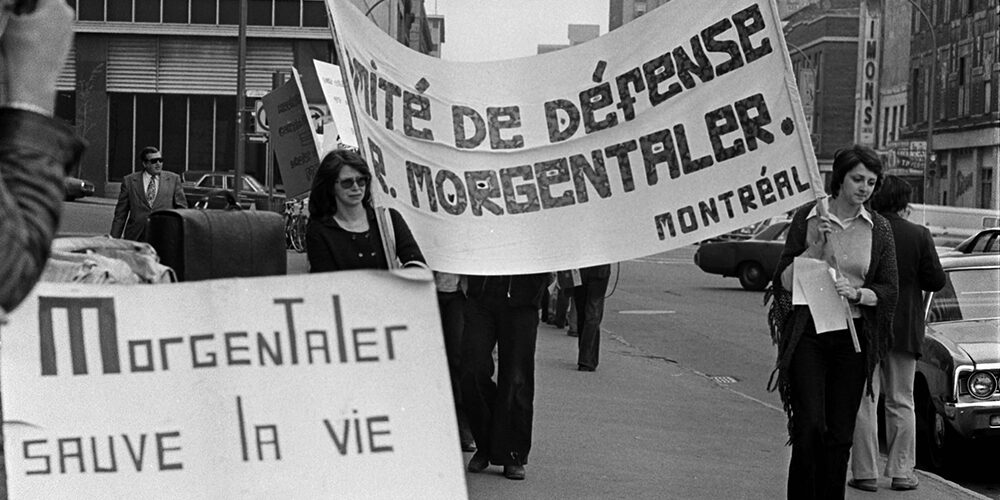Judy on coalitions
One important lesson about coalitions is that the ultimate goals of the group should outweigh any personal animosity between members.


Women rallying in support of Dr. Henry Morgentaler in 1975. Credit: Bibliothèque et Archives nationales du Québec

Over my 50-year experience as an activist, I have found that the most effective way to win a battle is by making connections across differences. We are doing that less and less these days in a time of polarized, denunciating politics but we have never needed it more.
One of the most successful coalitions that I was part of was the National Action Committee (NAC) on the Status of Women, the largest feminist group in Canada from 1972 til the early 21st century. I was the President of NAC for three years in the 1990’s during which we elected a diverse executive, with Indigenous, Black, immigrant, 2SLGBTQIA+ and disabled representatives probably the first in the country. But NAC began in 1972 with a politically diverse coalition. Young women, like me at the time, wanted revolutionary change and looked with disdain at older more conservative women like Laura Sabia, who was a Conservative councillor in a Toronto suburb. We may have recognized how rare it was to have a woman in this position but honestly we didn’t care, we wanted a revolution and to be completely equal with men. It was Grace Hartman, then a rare female President of a union, CUPE and Madeleine Parent, a working-class hero from Quebec who was charged by the neo-fascist Duplessis with treason for her union organizing, who convinced us to make an alliance with Conservative women who wanted an independent women’s group against Liberal women arguing that it be advisory to the government. NAC became the most effective women’s group in the country and perhaps in the world. It was a cross class, cross political party organization.
Another example of an effective coalition was the pro-choice movement that won abortion rights in 1988, making abortion a medical procedure like any other. A group of birth control providers and feminist activists in Toronto decided to try and set up an illegal abortion clinic like Dr. Henry Morgentaler did in Quebec. It’s a long story but the part of it I want to tell here was the coalition we built. From the group we contemptuously called the Rosedale Ladies, who raised money for the defense fund, to the labour movement, who taught us how to defend the clinic from anti-choice protesters to the church women who made sure we debated abortion issues on many Sundays, we built a very broad coalition.
The toughest challenge was the alliance between the Canadian Association for Repeal of the Abortion Law (CARAL), mostly middle-aged, middle of the road women who had been lobbying the government for decades to repeal the restrictive abortion law passed in 1969 and the Ontario Coalition for Abortion Clinics (OCAC), a younger, more radical group. They thought we were crazy and thought we would ruin everything with our more radical tactics. Nevertheless, we worked together even if we didn’t like each other so much. It came to head when the Catholic Church called out their troops, including Catholic schools, to protest in front of the clinic every day for a week. Up until that point the church had been doing their lobbying behind closed doors. They had a 1,000 people a day in front of the clinic on Harbord St., Monday to Thursday. The OCAC decided to organize a counter demonstration at Queen’s Park in front of the legislature on the Friday. CARAL opposed it. “We can never out mobilize the church,” they argued. “It will show our weakness.”
We considered their opinion, and we weren’t sure if we could out mobilize the church but what we did know was that it would demoralize all the people who had worked so hard to keep the clinic open on the streets and by building support in their workplaces and neighbourhoods. We decided to go ahead but then I learned something very important about coalitions. CARAL was furious with us, but they decided to do everything possible to build the biggest demonstration we could. They didn’t go off in a huff and denounce us. The movement is what mattered, and they did everything to build that demo even if it proved them wrong.
The media reported the Church demo’s every day. At the end of their report they said “and on Friday the pro-choice groups will be organizing a counter demo at Queen’s Park.” I will never forget standing on the steps of the Legislature, you could do that back then, and watching the waves of people emerging from the subway. It was huge. At least 15,000 people covered the grounds around Queen’s Park. It was a turning point.
Another example of an extraordinarily broad coalition was the Action Canada Network that formed to fight the free trade deal with the U.S, basically to fight neo-liberalism. The co-chairs were Maude Barlow, the leader of the Council of Canadians and a former Liberal and Tony Clarke who at the time was a senior staff person with the Conference of Catholic Bishops. This was during the pro-choice struggle and yet we managed to build a coalition against free trade at the same time as we were fighting each other in the streets over abortion rights. It must be said that Tony himself was pro-choice and later was fired by the Conference of Catholic Bishops for his activism. We won a majority of votes against the Free Trade Agreement but the free trade Tories won because of our undemocratic electoral system. By the time the Liberals came to power, they supported neo-liberalism even though they opposed it in 1988.

by Judy Rebick
RABBLE.CA
April 28, 2023
Over my 50-year experience as an activist, I have found that the most effective way to win a battle is by making connections across differences. We are doing that less and less these days in a time of polarized, denunciating politics but we have never needed it more.
One of the most successful coalitions that I was part of was the National Action Committee (NAC) on the Status of Women, the largest feminist group in Canada from 1972 til the early 21st century. I was the President of NAC for three years in the 1990’s during which we elected a diverse executive, with Indigenous, Black, immigrant, 2SLGBTQIA+ and disabled representatives probably the first in the country. But NAC began in 1972 with a politically diverse coalition. Young women, like me at the time, wanted revolutionary change and looked with disdain at older more conservative women like Laura Sabia, who was a Conservative councillor in a Toronto suburb. We may have recognized how rare it was to have a woman in this position but honestly we didn’t care, we wanted a revolution and to be completely equal with men. It was Grace Hartman, then a rare female President of a union, CUPE and Madeleine Parent, a working-class hero from Quebec who was charged by the neo-fascist Duplessis with treason for her union organizing, who convinced us to make an alliance with Conservative women who wanted an independent women’s group against Liberal women arguing that it be advisory to the government. NAC became the most effective women’s group in the country and perhaps in the world. It was a cross class, cross political party organization.
Another example of an effective coalition was the pro-choice movement that won abortion rights in 1988, making abortion a medical procedure like any other. A group of birth control providers and feminist activists in Toronto decided to try and set up an illegal abortion clinic like Dr. Henry Morgentaler did in Quebec. It’s a long story but the part of it I want to tell here was the coalition we built. From the group we contemptuously called the Rosedale Ladies, who raised money for the defense fund, to the labour movement, who taught us how to defend the clinic from anti-choice protesters to the church women who made sure we debated abortion issues on many Sundays, we built a very broad coalition.
The toughest challenge was the alliance between the Canadian Association for Repeal of the Abortion Law (CARAL), mostly middle-aged, middle of the road women who had been lobbying the government for decades to repeal the restrictive abortion law passed in 1969 and the Ontario Coalition for Abortion Clinics (OCAC), a younger, more radical group. They thought we were crazy and thought we would ruin everything with our more radical tactics. Nevertheless, we worked together even if we didn’t like each other so much. It came to head when the Catholic Church called out their troops, including Catholic schools, to protest in front of the clinic every day for a week. Up until that point the church had been doing their lobbying behind closed doors. They had a 1,000 people a day in front of the clinic on Harbord St., Monday to Thursday. The OCAC decided to organize a counter demonstration at Queen’s Park in front of the legislature on the Friday. CARAL opposed it. “We can never out mobilize the church,” they argued. “It will show our weakness.”
We considered their opinion, and we weren’t sure if we could out mobilize the church but what we did know was that it would demoralize all the people who had worked so hard to keep the clinic open on the streets and by building support in their workplaces and neighbourhoods. We decided to go ahead but then I learned something very important about coalitions. CARAL was furious with us, but they decided to do everything possible to build the biggest demonstration we could. They didn’t go off in a huff and denounce us. The movement is what mattered, and they did everything to build that demo even if it proved them wrong.
The media reported the Church demo’s every day. At the end of their report they said “and on Friday the pro-choice groups will be organizing a counter demo at Queen’s Park.” I will never forget standing on the steps of the Legislature, you could do that back then, and watching the waves of people emerging from the subway. It was huge. At least 15,000 people covered the grounds around Queen’s Park. It was a turning point.
Another example of an extraordinarily broad coalition was the Action Canada Network that formed to fight the free trade deal with the U.S, basically to fight neo-liberalism. The co-chairs were Maude Barlow, the leader of the Council of Canadians and a former Liberal and Tony Clarke who at the time was a senior staff person with the Conference of Catholic Bishops. This was during the pro-choice struggle and yet we managed to build a coalition against free trade at the same time as we were fighting each other in the streets over abortion rights. It must be said that Tony himself was pro-choice and later was fired by the Conference of Catholic Bishops for his activism. We won a majority of votes against the Free Trade Agreement but the free trade Tories won because of our undemocratic electoral system. By the time the Liberals came to power, they supported neo-liberalism even though they opposed it in 1988.
JUDY REBICK IS A CO-FOUNDER OF RABBLE
No comments:
Post a Comment